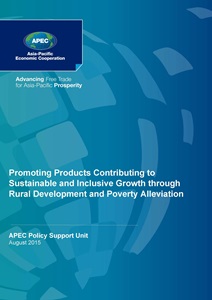Promoting Products Contributing to Sustainable and Inclusive Growth through Rural Development and Poverty Alleviation

| Published Date | September 2015 |
|---|---|
| Type of Publication | Reports |
| Publication Under | APEC Secretariat, APEC Policy Support Unit |
| Accessed | 12878 |
| Pages | 103 |
| Download publication | Download |
Description
This study responds to the call of APEC Ministers in 2013 by providing a framework to analyze the linkages between trade in certain products and the promotion of rural development and poverty alleviation, as a way to contribute to sustainable and inclusive growth.
The study shows that the discussion of the list of nominated products by APEC economies is relevant from both the trade and tariff perspectives. It shows that many of the nominated products have trade potential in world markets and enjoy comparative advantages. However, the main result of the elasticity analysis is the lack of significant results, pointing to the message that trade in the nominated goods per se is not enough to influence rural development and poverty alleviation. Rather, other factors such as institutional development, investment climate, access to healthcare and education, and social protection need to be considered. It is important to note that since this analysis was conducted for the APEC region as a whole, the results do not necessarily reflect the situation in any single APEC economy.
The study shows that the discussion of the list of nominated products by APEC economies is relevant from both the trade and tariff perspectives. It shows that many of the nominated products have trade potential in world markets and enjoy comparative advantages. However, the main result of the elasticity analysis is the lack of significant results, pointing to the message that trade in the nominated goods per se is not enough to influence rural development and poverty alleviation. Rather, other factors such as institutional development, investment climate, access to healthcare and education, and social protection need to be considered. It is important to note that since this analysis was conducted for the APEC region as a whole, the results do not necessarily reflect the situation in any single APEC economy.

